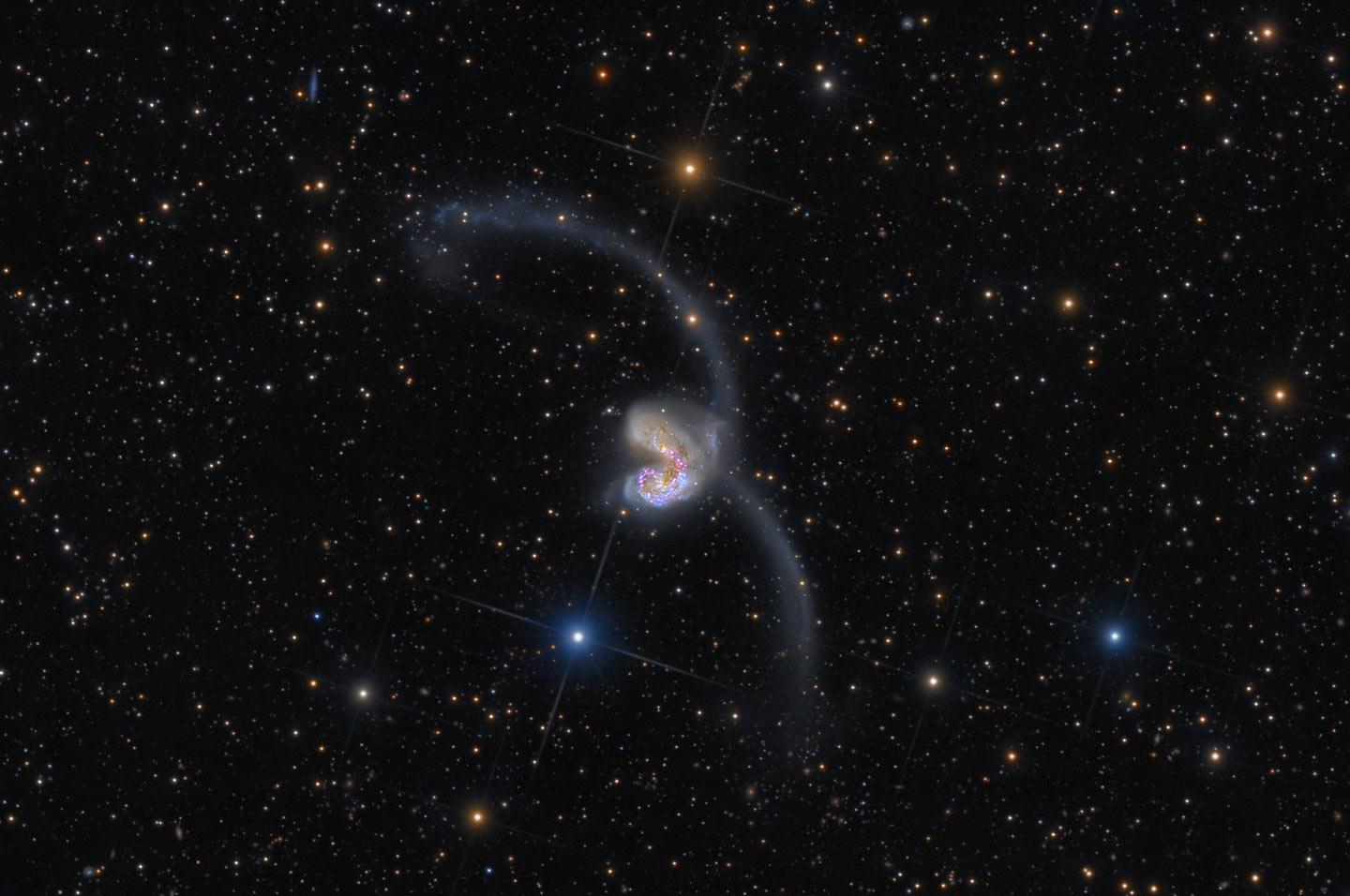Roughly 50 million light years from Earth is the most spectacular example of galactic collision in the sky: the famed Antenna Galaxies, two huge spiral galaxies in the middle of a cosmic train wreck. Playing out over hundreds of millions of years, the gravity of the two galaxies has distorted their shapes, flung out streamers of stars a million light years long, and triggered a burst of star formation so intense that billions of new stars are being born in the galaxy’s hearts.
As mighty as this event is, 50 million light years is a long, long way. The details of this collision used to be discernible only using giant observatories like the Very Large Telescope or Hubble.
But not anymore! Behold Rolf Wahl Olsen’s newly released picture of the Antennae and prepare to scrape your jaw off the floor (you’ll want to make your browser wider for this):

Photo by Rolf Olsen
That magnificent shot was taken with—get this—a 32 cm (12.5”) telescope Olsen built himself. It took him 38 nights of observing from January to June 2014 to get to a total of an amazing 75 hours of observing time for this gorgeous image. He says the faintest stars visible are around 24th–25th magnitude; the faintest star you can see with your naked eye is 25 million times brighter than that.
So yeah, this picture is deep.
The detail really is stunning. Olsen compared his image to those taken with Hubble and the VLT, and while of course his resolution isn’t as good (there’s no way a small telescope can discern details as well as much larger telescopes), it’s amazing what features you can identify in his shot compared with the professional observatories.

Photo by Rolf Olsen
What you’re seeing in this image are two massive galaxies undergoing a physical collision. Over the lifetime of the Universe, galaxies collide fairly often; our own Milky Way has collided with and consumed quite a few smaller galaxies to grow to its current size. But collisions between two large galaxies is more rare, and we’re fortunate to have such a fantastic example like the Antennae so close to us.
The collision started more than 600 million years ago. As they approached each other, their mutual gravitational attraction drew out long streamers of stars (called tidal tails) from the other. The galaxies aren’t colliding perfectly head on, but instead first missed each other by a bit. Their gravity swung the two galaxies around, giving them a bit of rotation; that’s why the tidal tails form long, graceful arcs.
After they swung around, the galaxies headed for each other again, colliding for a second time and starting the long, long process of merging into a single, larger galaxy. Amazingly, it’s unlikely there will be a single collision between two stars; stars are very small compared with the space between them. But gas clouds are huge, light years across, and collisions between them are common in these events. When clouds slam into each other they collapse and form stars. These collisions can spur huge amounts of such activity, creating what we poetically call a starburst. In Olsen’s image, the clouds are pink and red due to glowing hydrogen gas, excited by the vast numbers of massive stars forming within them.
Star birth also creates huge amounts of dust—long, complex molecules based on carbon—which is opaque, so the dust clouds block the light from stars behind them. You can see the ribbons and filigrees of dust in Olsen’s image, and of course even better in the VLT and Hubble pictures.
If you still need one more thing to send chills down your back, then think on this: In 4 billion years the Milky Way will collide with the massive Andromeda Galaxy, and if there are any spectators a few dozen million light years away, what they will see all those eons hence will look very much like what Olsen has shown us here.
It’s simply mind-blowing to see what can be done with so-called amateur equipment these days. What was once the sole purview of professional observatories (before the invention of the digital camera) can now be reproduced with far less, if someone is willing to be so devoted to it. I’m glad Olsen is.
And if you need more of his work, then you should see his images of the active galaxy Centaurus A, his glimpse of a forming alien solar system, and what he did with Voyager images of Neptune. It takes him a long time to put together each of these shots, and so we don’t hear as much from him as other folks putting their eyepieces to the sky. But if he continues to create such astonishing works like these, I can be patient. It’s worth it.